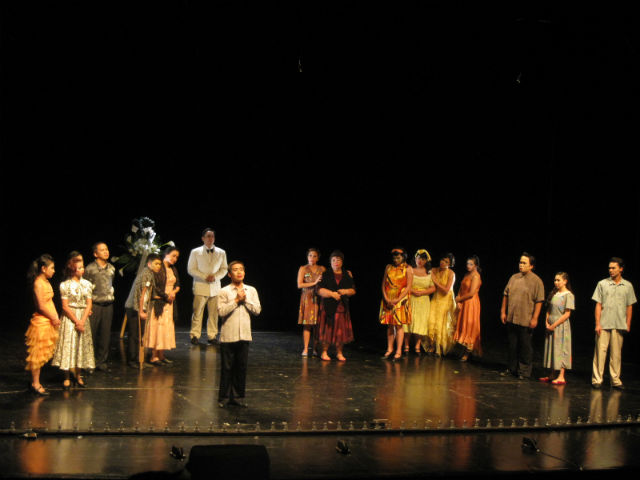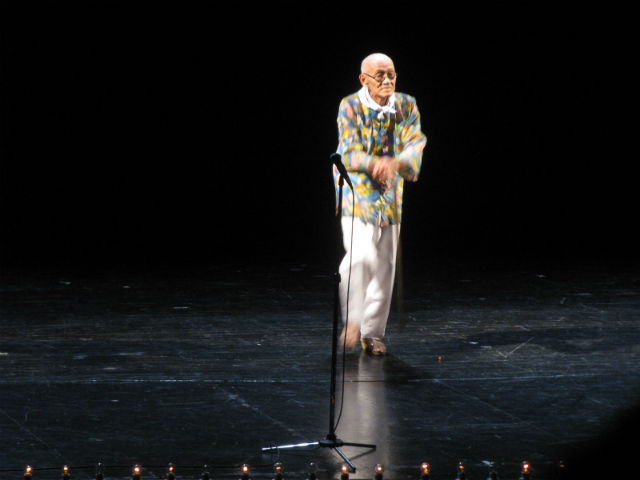Filtered By: Lifestyle
Lifestyle
Theater review: Desire and disappearance in 'Stageshow'
Text and photos by KATRINA STUART SANTIAGO
It is rare that a stage production brings me to tears, and I remember two that have: Repertory Philippines’ “Next Fall” and Atlantis Productions’ “Next To Normal.” 

An empty stage, a small group of actors, a filled heart for "Stageshow."
Yet, it seems to be an injustice to “Stageshow” that I would compare it at all to these. Because here is a Mario O’Hara text, brought to life by Tanghalang Pilipino, making it an all-original Filipino production. And did I mention it’s a musicale, too? That it’s funny, at times risqué, absolutely what you don’t expect? This is reason enough to think this in a league different from those foreign productions staged locally; then you find yourself in tears at the end of it and you know this is something rare and wonderful.
Days since, this “Stageshow” hangover is beyond me.
Because there are many things that makes it unforgettable, but to throw one out for size seems unfair. To say that Shamaine Centenera-Buencamino in the lead, or Liesl Batucan as her alternate, or the choreography of Denisa Reyes, or the music, or the comedy make for this production’s success—granted that all of these are true—would not do it justice. To some extent, words don’t capture what this production is, what it sought out to be.
Which are multiple things, all happening at the same time.
Say, a sad reminiscence about the golden years of Philippine entertainment when the stageshow brought stand-up comedy, song and dance numbers, and routines ala Dolphy and Panchito to local audiences. Where this reminiscence happens through characters that have lived through those years to the present, where their aging is a form of disappearance. This is the shift from stage to film to TV, which meant the death of the talented, the survival of the few. 

Tony Casimiro, tap dance choreographer, special guest on gala night, all 72 years old of him.
Yes, this is also a remembering of those who did survive, the ones we have come to know as Bayani Casimiro and Bentot, Chichay and Sylvia La Torre. They are mentioned in “Stageshow” as many other names are, and we are reminded of the kind of forgetting we engage in, the kind of remembering we do not know to do. In a country that lives off celebrity, given an entertainment industry that creates fame out of nothing—the younger the better, talent is secondary—this remembering can only be painful.
These names force us into thinking of real people, and it’s a disjunction that works for this fictional narrative. This is not just fiction.
Fact: we do not look kindly upon the aging and aged, yes, but also we frown at the different. In this day and age of homogenized faces and bodies, our sense of talent is clouded by the preoccupation with the physical.
“Stageshow” is inevitably about this as well. About how the skill in entertaining is something that stays, regardless of age or celebrity status. Unbridled talent persists even when ignored, and these artists that the play talks about from the past exist in this present. These artists live. Even when they are not on TV or in film.
Here is why this production is far larger than it actually is. Because in its staging we become witness to the truths it speaks of, about culture and creativity, and how it is the least of our priorities. 

Nonie Buencamino as male lead is a joy onstage.
But they are larger than life here. The Centenera-Buencamino (Ester) and Nonie Buencamino (Tirso) combination is unbeatable, as these two are artists on that stage, navigating it like the back of their hands, until they are their characters. Buencamino’s Tirso is the right amount of swagger and macho through most of the narrative, whose turn into compassionate and regretful is so convincing, that you forgive. Centenera-Buencamino’s Ester meanwhile is a woman with a mission: that is, to tell this story, carry it on her shoulders, stomp her feet to the beat, rock it like there’s no tomorrow. She takes on this character, and does not only do justice to its evolution, but even more so to its humanity—the ability to forgive, and ultimately to love, is at the core of this portrayal. To say that the Buencamino couple was brilliant is a failure in itself.
And yet there is also the Liesl Batucan and Roeder Camañag combination, which brings to Ester and Tirso a playfulness that breathes life into the risqué and funny in this narrative. Batucan’s Ester is light with her step and quick on her feet, and her use of her body as aging mechanism is the most believable you will ever see anyone do, where she subtly shifts her stance and movements, and the next thing you know she had aged. Then you recognize the hint of it in her voice, and you find that Batucan’s Ester had exquisitely and gracefully evolved. Into this woman, who in the end speaks only of love, of starting over, of persistence, in living and loving, both. But there is desire, too, and this Batucan’s Ester shared with Camañag’s Tirso, who did desire to the hilt—literally in the sense of bastos and libog, but with a charm that is particularly Pinoy macho. This Tirso is rebel with no cause, womanizer and drinker, his regret and anguish particularly the lost boy kind. Of course this has everything to do with Camañag, with a voice that doesn’t falter, and tap-dancing that brings sexy back.
Which is to say that “Stageshow” is also about desire, the one we equate with love, also just that one that’s about sex. That the women speak about it as much as the men do, that they are having as much sex on that stage, and that all of them can make fun of it, is a most liberating thing to watch. This is of course the work of an ensemble, one that literally carries the parts of the set on and off stage, and then delivers punchlines without missing a beat. That this ensemble also dance and writhe and tap-dance skillfully on that stage is tribute to times past, yes, but also to the work of choreographers Denisa Reyes and Tony Casimiro (for tap). Here, it is the dancing that creates the cityscape and carries with it a sense of community, at the same time that it stands for imagination and emotion. This choreography can only be an up-yours to the stage productions that do nothing but mimic their foreign counterparts; it’s an up-yours to an audience that thinks that there is less talent where we come from.
And there is even more of it on “Stageshow.” Worth mentioning are the lighting design by Katsch SJ Katoy, the costumes by Brenda Fajardo, and the musical direction by Jeff Hernandez. Director Chris Millado’s hand is clearly in having let this text tell itself, in having let actors act, in letting the silences happen. The staging of this form could’ve been messy in the hands of someone without vision; with Millado, the imagination of the text, its intricacies and self-referentiality, its ironies and truths, is the grand narrative that he holds up for the audience to see.
Along with this cast, what resonates as such is that layer that is about persistence and survival, not of the fittest, but of the more creative among us. Because at the core of the creative spirit, at the heart of his persistence, is undeniable desire. It is what tides us over, it is what keeps us alive. And lest we imagine this romantic, another thread that runs through this narrative, is that of abject poverty and real hunger vis-à-vis politics and government neglect.
Yup, tragically familiar. “Stageshow” will give you the song and dance number for it. –KG, GMA News
“Stageshow” is a Tanghalang Pilipino production, running on its last week, with evening shows from October 17 to 20, and a matinee on October 21. Contact Cherrybong at 0917-7500107 | Lei at 0908-8941384 | Enzo at 0935-3784781 for tickets. This is the last of Mario O’ Hara’s works. He died in June of this year.
Katrina Stuart Santiago writes the essay in its various permutations, from pop culture criticism to art reviews, scholarly papers to creative non-fiction, all always and necessarily bound by Third World Philippines, its tragedies and successes, even more so its silences. She blogs at http://www.radikalchick.com. The views expressed in this article are solely her own.
More Videos
Most Popular



